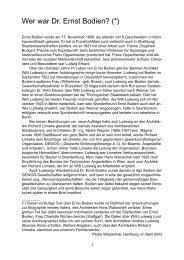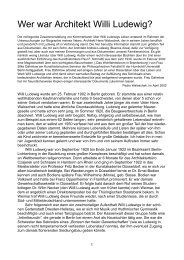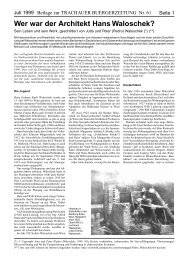Death-Rays as Life-Savers in the Third Reich - Pedro Waloschek ...
Death-Rays as Life-Savers in the Third Reich - Pedro Waloschek ...
Death-Rays as Life-Savers in the Third Reich - Pedro Waloschek ...
Create successful ePaper yourself
Turn your PDF publications into a flip-book with our unique Google optimized e-Paper software.
atl much lower electron energies, where <strong>the</strong> produced X-rays are<br />
distributed more or less evenly <strong>in</strong> all directions, across <strong>the</strong> entire<br />
space. The more energy <strong>the</strong>re is, <strong>the</strong> narrower becomes <strong>the</strong> cone <strong>in</strong><br />
which <strong>the</strong> X-rays are produced. This k<strong>in</strong>d of <strong>in</strong>tense bundl<strong>in</strong>g is of<br />
major importance when <strong>the</strong> aim is to direct <strong>the</strong> produced radiationto a<br />
target.<br />
Ano<strong>the</strong>r important <strong>as</strong>pect is <strong>the</strong> range of <strong>the</strong> radiation when it<br />
penetrates matter. I shall go <strong>in</strong>to this subject <strong>in</strong> more detail later on.<br />
This concerns on one side <strong>the</strong> range <strong>in</strong> air, i.e. ensur<strong>in</strong>g that sufficient<br />
radiation reaches its target, but on <strong>the</strong> o<strong>the</strong>r side <strong>the</strong> radiation should<br />
also be able to penetrate relatively thick walls or shields made from<br />
solid materials. In both c<strong>as</strong>es <strong>the</strong> calculations are <strong>the</strong> same <strong>in</strong> pr<strong>in</strong>ciple.<br />
B<strong>as</strong>ed on density it is possible to predict that <strong>the</strong> range <strong>in</strong> solid<br />
materials will be roughly a factor thousand smaller than <strong>in</strong> g<strong>as</strong>ses under<br />
atmospheric pressure, which <strong>in</strong>cludes air. In <strong>the</strong> latter c<strong>as</strong>e it is<br />
necessary to calculate <strong>the</strong> distance at which a device may still be able<br />
to irradiate an object with sufficient <strong>in</strong>tensity to cause some def<strong>in</strong>ed<br />
damage or, <strong>in</strong> extreme c<strong>as</strong>es, <strong>the</strong> death of <strong>the</strong> irradiated human be<strong>in</strong>g.<br />
Naturally, this w<strong>as</strong> what <strong>the</strong> military were hop<strong>in</strong>g to achieve. By <strong>the</strong>n<br />
medic<strong>in</strong>e had already provided some data on <strong>the</strong> radiation dose<br />
required to damage or kill cells (such <strong>as</strong> cancer cells) or an entire liv<strong>in</strong>g<br />
creature. Schmellenmeier <strong>as</strong>sumed that he would never be able to<br />
achieve such a high level of <strong>in</strong>tensity.<br />
The penetration of solid materials is <strong>in</strong>terest<strong>in</strong>g for quite different<br />
re<strong>as</strong>ons. It w<strong>as</strong> already known that ‘harder’ X-rays, i.e. produced by<br />
electrons of higher energy, could penetrate thicker layers of matter.<br />
Materials research experts could only dream of 20 to 100 MeV Xrays<br />
that would enable <strong>the</strong>m to X-ray thick work pieces. But that k<strong>in</strong>d<br />
of Voltage (to which <strong>the</strong> electrons would first have to be accelerated)<br />
w<strong>as</strong> not available <strong>in</strong> those days.<br />
Relatively little w<strong>as</strong> known at <strong>the</strong> time about <strong>the</strong> range <strong>in</strong> air of<br />
high-energy X-rays. To meet military requirements <strong>the</strong> range needed<br />
to be at le<strong>as</strong>t one, although preferably several kilometres <strong>in</strong> order to<br />
46











